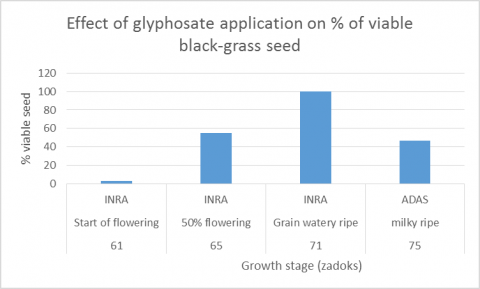Sarah Cook
In winter crops weed infestations have become more evident. It is time to review past control measures and plan for the future. In spring crops weeds will be several weeks behind.
Firstly, map patches of weeds and spray out bad patches of black-grass and Italian ryegrass before they set seed, there is still time before seeds become viable from the 1st week in June.
Hand pulling is a viable option for low populations as each black-grass plant can produce 100 seeds from each head, so a large well tillered plant with 20 heads could produce 2000 seeds. A well tillered Italian ryegrass can produce 5,000 seeds from a plant with 20 tillers. A single plant can become an infestation within 2 years if not dealt with.

Leaving control to pre-harvest glyphosate will only kill a few late tillers of black-grass as the majority of seed will have shed. Italian ryegrass remains greener for longer. Brome will already be dead.
Figure 1, shows the percentage of black-grass seed that remains viable after spraying off with glyphosate at the later growth stages, the data shows some variation, but viable seed can be present any time after the start of flowering. The later it is left then the more viable seed there will be.
It’s too late to control sterile or great brome now by mowing as the seeds are already viable, but mowing now will prevent them being picked up by the combine and spread further into the field.
Meadow and rye brome are just coming into head (Figure 2), becoming visible above the crop. Patches can be sprayed or mown out. It’s important to identify what brome species is present as this affects the optimum timing for control. Meadow and rye bromes are later to come to head. Rye brome is much less hairy than meadow brome, more erect and stiff. Meadow brome is much hairier, more silver in colour, similar to wheat.
Wild oats
It’s also the time to plan for roguing out patches of common wild-oats (Avena fatua) and winter wild-oat (Avena sterilis spp. Ludovociana), these tend to be a forgotten weed, but they are becoming resistant to a wider range of herbicides – ‘fops’, ‘dims’, ‘dens’ and ALS. Resistance to ‘fops’ is more widespread than to ‘dims’ and ‘dens’. Remove all plants from the field as the seed may already be fertile.
| ACTION - Destroy patches of black-grass as soon as possible to prevent viable seed return. - Identify brome species whilst heading. - Rogue out patches of wild oats. |

